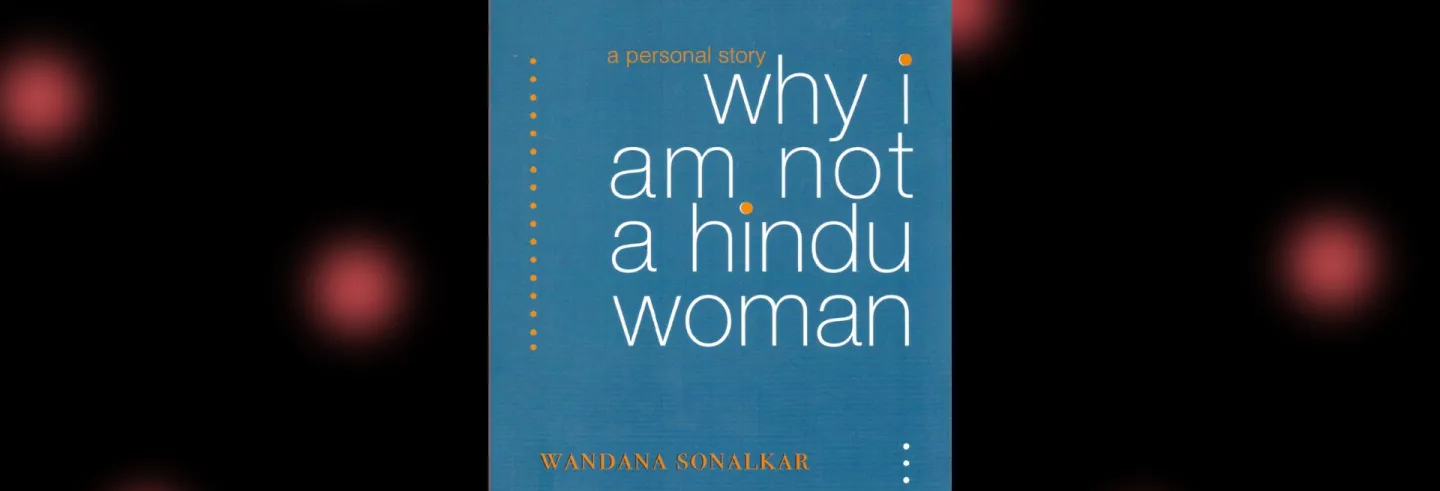The last three decades have led to turmoil among thinking ‘Hindus’ who have watched the violence, hyper-masculinity, and hatred of a Hindutva they have not been able to stop from coming to power. Yet not many persons in this thinking and liberal-democratic community have made a public declaration of renouncing what would be assumed to be their Hindu identity. Wandana Sonalkar has done that by writing a book that traces the growing awareness of a girl and a woman. Her personal story becomes the basis of critical reflections on what a ‘Hindu’ identity means today and why it needs to be formally ‘renounced’, and even denounced.
The title of Sonalkar’s book is a take on Kancha Ilaiah's famous Why I am Not a Hindu (1999), which made waves for its polemical stance and public declaration of a renunciation of the Hindu identity derived from birth in a "Hindu" family. It is perhaps also a take on Bertrand Russell’s Why I Am Not a Christian, a book Sonalkar alludes to in her critique of Hinduism, Hindutva, caste, and patriarchy.
Sonalkar’s important book is a set of reflections derived from the uncertain terrain of childhood and young adulthood experiences owed to contradictions within families. While nothing in one's experiences is really ‘unique’, the manner in which they are experienced can well be momentous enough to create a sense of alienation from one's surroundings. They can lead to critical thinking on family, society, tradition, religious belief, and the instrumentality of casting religious belief as distinctively political.
Caste and patriarchy
As early as the 1880s, Pandita Ramabai (who too renounced her Hindu identity) had observed that at marriage women become ‘dependent’ on their husbands. Despite the hours of labour women put into the reproduction of the household, they are presumed to be obliged to their husbands because ‘he feeds her’. The naturalised power of the Hindu male empowers him to make decisions for the rest of the household. That remains the dominant ideology even in post-independent India. Women, even though educated, do not always work; and the man is the ‘breadwinner’.
These domestic circumstances have often led to turmoil in families. Decision making lies is in the hands of the husband or father. The mother retreats into prayer and takes recourse to her ‘pativrata dharma’. The children begin to fall apart. This can be deeply traumatic and leave scars that can impact a growing girl and her understanding of patriarchy as it works out even in a liberal Hindu household. It is only with adult life and the choice of studies and careers, that ideas are born, grow, and shape ways of being.
Sonalkar’s denunciation of Hinduism […] is a rejection of the misogyny that is deeply rooted in a Hindu patriarchy that cuts across castes.
Sonalkar’s life and social location are not unusual. She is upper caste, but not Brahmin, and is firmly a part of the upper-caste middle class educated elite that more or less naturally constituted the professional class in post-independence India. The critical years of Sonalkar’s life are when she assumes control over her own decisions and throws herself into politics. She has a pratilomic marriage — marrying below a woman's caste — a particularly reprehensible form of marriage in the Manudharma Shastra. This is the beginning of a rejection of a caste-based patriarchy.
The marriage is unusual, but not extraordinary for people in left-democratic circles, a space firmly occupied by Sonalkar and her partner. It is her move to Aurangabad University as a teacher in 1979 that radically sharpens her understanding of the workings of caste in the social life of all its members.
The entire city is divided by caste, food, and social power and imposes identities upon inhabitants. Where can one live? Which colonies are vegetarian and will not allow meat-eaters in? It is also the time when the violence of the namantaran movement is unleashed as the name of Sonalkar’s university is to be changed to honour Ambedkar, who had created many educational institutions in the city. The violent reaction makes starkly visible the pernicious working of caste in constitutional India despite the promise of equality.
It is here that Sonalkar’ oppositional stance begins to take shape. Her position is different from that of Ilaiah, who experiences caste-based discrimination. As an upper-caste woman, Sonalkar’s denunciation of Hinduism comes from a woman's standpoint, going beyond an intellectual and ethically feminist standpoint. As she puts it, hers is a rejection of the misogyny that is deeply rooted in a Hindu patriarchy that cuts across castes. This misogyny is sustained (italics mine) by caste as Hinduism sacralises inequality among human beings (24).
The end of dialogue
This growing understanding has crystallised over many decades. However, the political conjuncture that we have been embedded in since the 1990s creates the imperative to name the structure and the set of beliefs being re-affirmed by the Hindutva state, and then to break with the system that is being forced upon the people.
In the early 1990s, well-meaning secular groups felt they could engage in a dialogue with people who espoused a more aggressive Hinduism […] The discussions ran their course but did not turn the tide against a hardline Hindutva coming to dominate the public sphere.
We are now at a different time. In the early 1990's, well-meaning secular groups felt they could engage in a dialogue with people who espoused a more aggressive Hinduism. Secular swamijis like Agnivesh were sought by anti-communal groups to have dialogues and street corner debates with hardline Hindus. Academics and activists wrote in newspapers and spoke in public meetings. The discussions ran their course but did not turn the tide against a hardline Hindutva coming to dominate the public sphere.
This hardline Hindutva leaves little room for discussion, reason and tolerance for different ways of being. Social media — the ‘WhatsApp universities’, as the media person Ravish Kumar has titled them — has generated even more hatred. Upper caste Hindu families seem to be fully implicated in circulating hatred against Muslims and dissenters within the family. WhatsApp groups are splitting families down the middle. Violence of all kinds is justified. The incarceration of young women with political minds of their own is not condemned as publicly as it should be.
Simultaneously, caste atrocities are escalating. Young dominant-caste men rape and kill Dalit women, but their social power over the countryside and protection by state power ensure they rarely get punished. Equally perverse is the violence families inflict upon young women who choose to marry or love across community boundaries. Caste and patriarchy are impossible to disentangle in India.
Looking forward
The strongest part of Sonalkar’s book is her critique of caste. It is written from the point of view of a feminist, born by happenstance in a Hindu family. She draws from Manu's diktats to reiterate her critique of Hindu patriarchy. It is a structure from which Hindutva draws, building upon the deep roots of violence in a caste-based patriarchal Hindu social order. It must be abjured. It is fitting therefore that Sonalkar’s ends her book with a summation of her rejection of a Hindu identity.
Having abjured her Hindu identity, Sonalkar can look forward to change, and perhaps leave it to the Dalit feminists to spearhead that change, one in which others can also participate.
That, in a sense, is about the past. What of the future? Sonalkar says that her position is not derived from a Dalit feminist standpoint, as her life has not been that of a Dalit woman. It is that of an upper-caste woman, a feminist who has tried to learn from being in that upper caste location, one who accepts that leadership for social change will come from elsewhere, from another generation, another caste, another class. It is from that position that she writes about why she is not a Hindu woman.
Having abjured her Hindu identity, Sonalkar can look forward to change, and perhaps leave it to the Dalit feminists to spearhead that change, one in which others can also participate whatever ‘identity’ they may have been placed in by accident of birth. Sonalkar’s book leaves its sympathetic reader and feminists of all hues with hope for a casteless and humane society. Never mind how depressing the present may appear to be.









